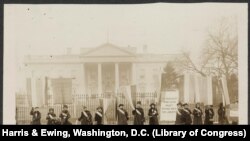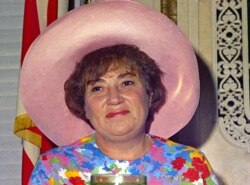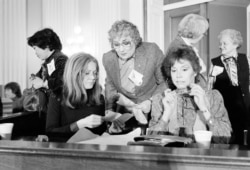Women’s Equality Day, observed every August 26, commemorates the adoption of the 19th Amendment to the U.S. constitution, which gave women the right to vote.
This historic action, however, would not have been possible without the women’s suffrage movement. Among the leaders of that group was Alice Paul, the oldest of four children of wealthy and progressive Quaker parents.
She had been seemingly groomed for lofty dreams and public service. Her mother, Tacie Parry Paul, was a suffragist who brought her daughter with her to women's suffrage meetings.
Alice Paul attended Swarthmore College, a Quaker school in Pennsylvania cofounded by her grandfather, and graduated with a biology degree in 1905. She also received a master of arts degree in sociology and later traveled to England to study social work.
Through all of her studies, she remained a devoted suffragist.
While in London, she learned militant protests tactics, including picketing and hunger strikes, which she used after returning to the United States. Her first demonstration, and the largest, was in Washington, D.C., on March 3, 1913, the day before President-elect Woodrow Wilson's inauguration.
Approximately 8,000 women marched down Pennsylvania Avenue from the U.S. Capitol to the White House. They were gawked at and jeered. Four years later, after failing to convince Wilson of the need to amend the constitution, Alice Paul and more than 1,000 "Silent Sentinels" began 18 months of picketing the White House. She was harassed, attacked and even jailed for seven months.
Even though by 1918 Wilson had announced his support for suffrage, it took another two years for the Senate, House and the required 36 states to approve the amendment.
Not to rest on her success, Paul went on to write the Equal Rights Amendment in 1923, which called for absolute equality saying, "Men and women shall have equal rights throughout the United States and every place subject to its jurisdiction."
Her supporters proposed the amendment in every congressional session between 1923 and 1972, but it was never passed. Finally, in 1972 both houses of Congress passed the amendment. There was a seven-year deadline set for the ratification by three-fourths of the 50 states. But by the 1982 deadline, the ERA was three states short of the 38 needed to become a constitutional amendment.
Unfulfilled dream
It has never been ratified. Despite that, women in America continue to push for equality in the eyes of the law. In 1973, Congresswoman Bella Abzug of New York introduced a resolution to designate August 26 as Women's Equality Day.
This year marks the 99th year of the adoption of the 19th Amendment.
Through history, women have helped propel American politics and civil rights to the modern day. Women such as Betty Friedan, Rosa Parks and Gloria Steinem played key roles in the women's rights movement and the passage of Civil Rights legislation in the 1960s.
January 2019 saw a record-breaking number of women, people of color, and LGBTQ representatives take the oath of public office.
In 2018, dubbed the "Year of the Woman," 117 women were elected or appointed to Congress. That's a long way from the last "Year of the Woman" when 28 women were elected to Congress in 1992.
Historical suffrage
The launch of the women's suffrage movement in the United States is attributed to a convention in Seneca Falls, New York, in 1848, led by Elizabeth Cady Stanton and Lucretia Mott. The participants demanded a wide range of rights: education, economic rights, the right to a good job, the right to own property and the right to vote.
For the next 50 years, suffrage supporters worked to educate the public about the importance of granting women the right to vote.
They formed two organizations that took the mantle of the movement. The National American Woman Suffrage Association, under the leadership of Carrie Chapman Catt, was a moderate group that worked to petition politicians and lobby local and state officials to bring about change. The National Woman's Party, under the leadership of Alice Paul, was a more militant organization. The NWP undertook more radical actions, including picketing the White House and organizing women's marches across the country.
Their combined efforts are what led to the passage of the 19th Amendment in 1919.
Marking the passage
Museums, institutions, nonprofits and civic groups across the country are celebrating next year's centennial of the ratification.
Some of the noted commemorations of the event are taking place in the nation’s capital. Among them are:
The National Portrait Gallery: The "Votes For Women: A Portrait of Persistence" exhibit shines a light on the often-overlooked contribution of black suffragists like Ida B. Gibbs, who taught at Washington’s first all-black high school and founded the first YWCA for black women.
The National Archives: The original 19th Amendment will be on display along with photographs, documents and audio-visual recordings. The "Rightfully Hers: American Women and the Vote" exhibit will also include an 1877 petition for universal suffrage signed by black and white suffragists and a patent drawing for a gendered voting machine from 1910.
Library of Congress: The extensive collection of letters and documents of such figures as Susan B. Anthony, Stanton, Mary Church Terrell, Catt, the National Woman's Party and the National American Woman Suffrage Association will be on display at the "Shall Not Be Denied: Women Fight for the Vote" exhibit.
Most exhibits run through next year. There also will be regional and state commemorations to mark the centennial.











